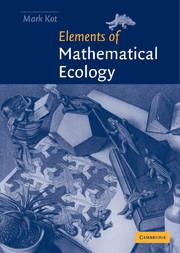Book contents
- Frontmatter
- Contents
- Preface
- Acknowledgments
- I UNSTRUCTURED POPULATION MODELS
- 1 Exponential, logistic, and Gompertz growth
- 2 Harvest models: bifurcations and breakpoints
- 3 Stochastic birth and death processes
- 4 Discrete-time models
- 5 Delay models
- 6 Branching processes
- 7 A classical predator-prey model
- 8 To cycle or not to cycle
- 9 Global bifurcations in predator–prey models
- 10 Chemostat models
- 11 Discrete-time predator–prey models
- 12 Competition models
- 13 Mutualism models
- 14 Harvest models and optimal control theory
- II STRUCTURED POPULATION MODELS
- References
- Author index
- Subject index
4 - Discrete-time models
Published online by Cambridge University Press: 05 August 2012
- Frontmatter
- Contents
- Preface
- Acknowledgments
- I UNSTRUCTURED POPULATION MODELS
- 1 Exponential, logistic, and Gompertz growth
- 2 Harvest models: bifurcations and breakpoints
- 3 Stochastic birth and death processes
- 4 Discrete-time models
- 5 Delay models
- 6 Branching processes
- 7 A classical predator-prey model
- 8 To cycle or not to cycle
- 9 Global bifurcations in predator–prey models
- 10 Chemostat models
- 11 Discrete-time predator–prey models
- 12 Competition models
- 13 Mutualism models
- 14 Harvest models and optimal control theory
- II STRUCTURED POPULATION MODELS
- References
- Author index
- Subject index
Summary
For many organisms, births occur in regular, well-defined ‘breeding seasons’. This contradicts our earlier assumption that births occur continuously. I begin this section by describing the life histories of some organisms with discrete reproduction. We will then consider some simple discrete-time models that are well-suited to these organisms.
Plants
Herbs often flower in their first year and then die, roots and all, after setting seed. Plants that flower once and then die are monocarpic. Many monocarps are annuals, but a few species have long lives. Bamboos are grasses, but they grow to unusually large size. Many species of bamboo grow vegetatively for 20 years before flowering and dying; other species have flowering times of 1, 3, 11, 15, 30, 48, and 60 years (McClure, 1967). One Japanese species, Phyllostachys bambusoides, waits 120 years to flower (Janzen, 1976). A few species of bamboo also synchronize reproduction within cohorts. This may have disastrous consequences for organisms that subsist on bamboo. In the spring of 1983, the simultaneous mass flowering and death of Fargasia spathacea and Sinarundinaria fangiana resulted in the starvation of many pandas within their main reserve in China. Another long-lived, monocarpic plant is the desert agave, Agave deserti (one of about 10 plants referred to as century plants), which routinely lives 20 to 25 years before flowering.
Most trees flower repeatedly. However, Foster (1977) has characterized Tachigalia versicolor as a ‘suicidal neotropical tree’. After reaching heights of 30–40 m, it flowers once and then dies.
Insects
Semelparityf † is for animals what monocarpy is for plants.
- Type
- Chapter
- Information
- Elements of Mathematical Ecology , pp. 43 - 69Publisher: Cambridge University PressPrint publication year: 2001



